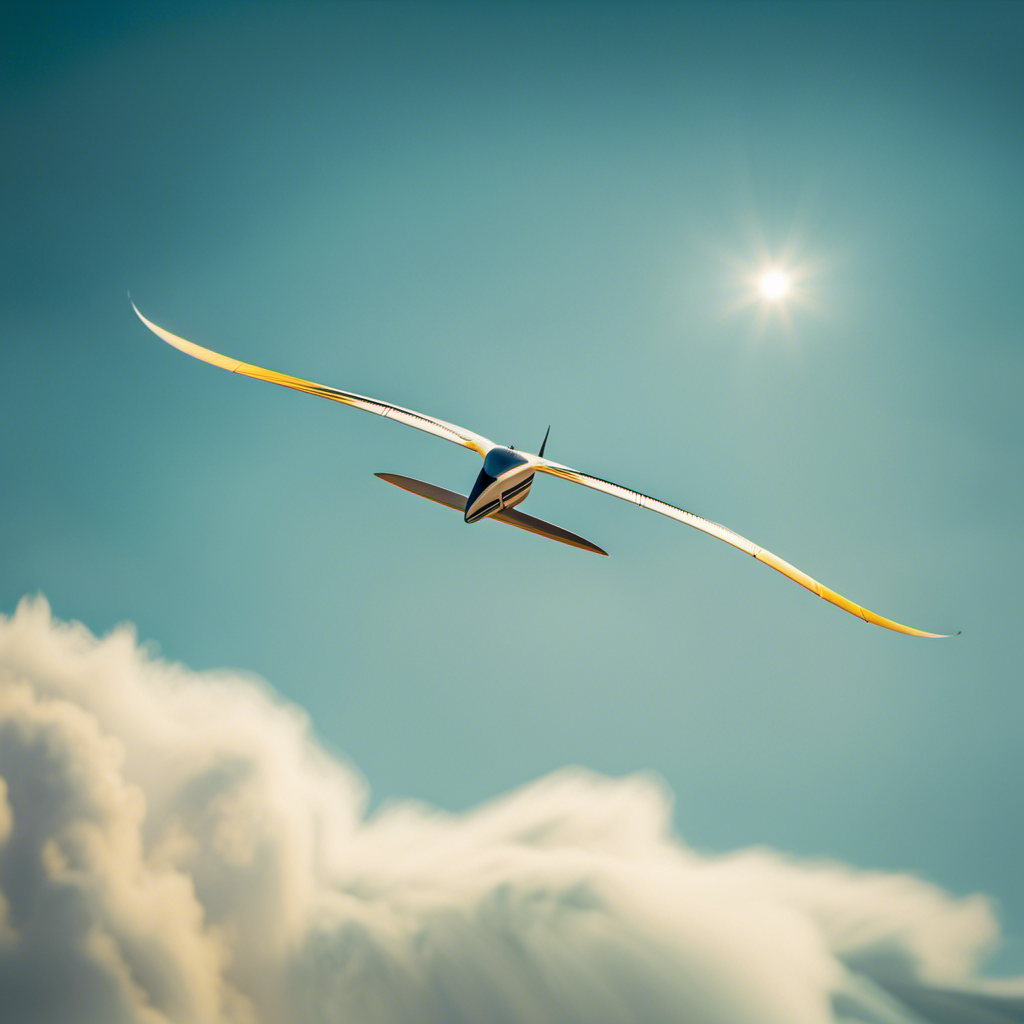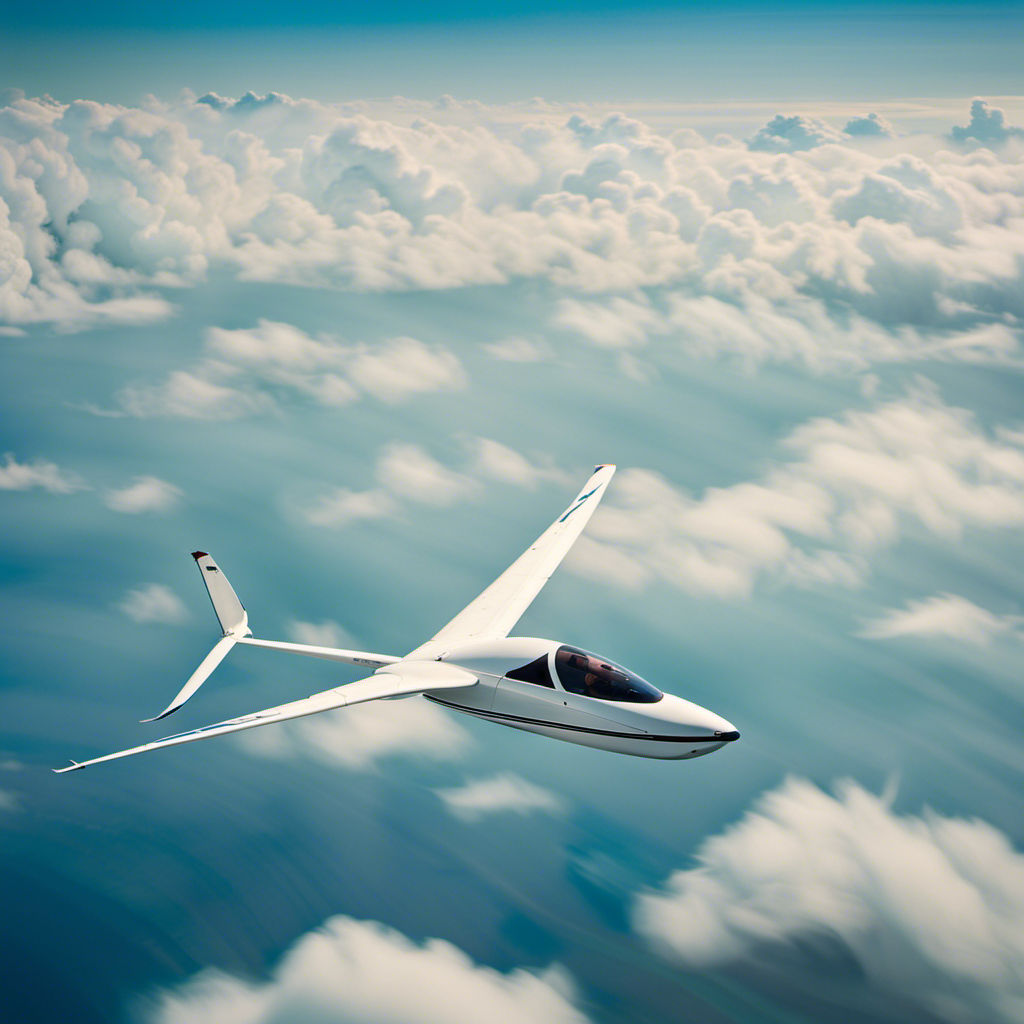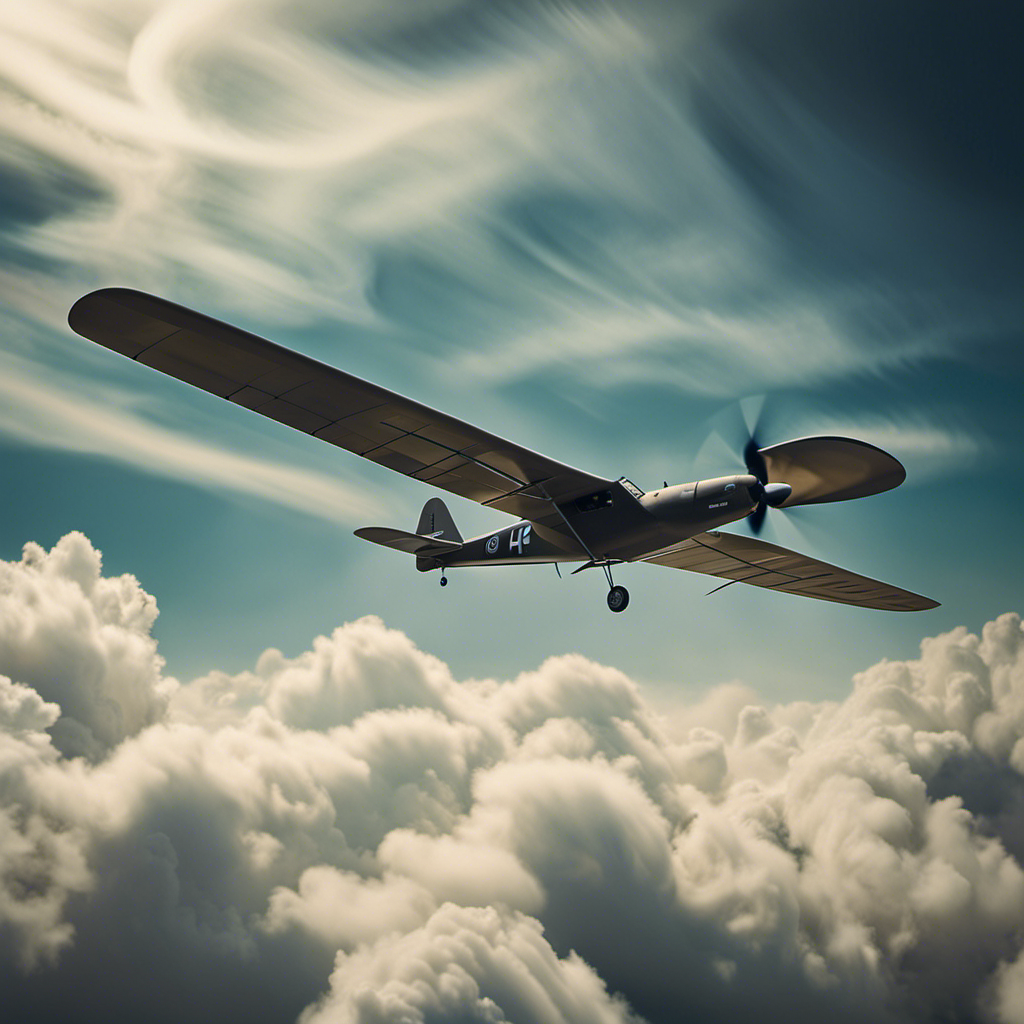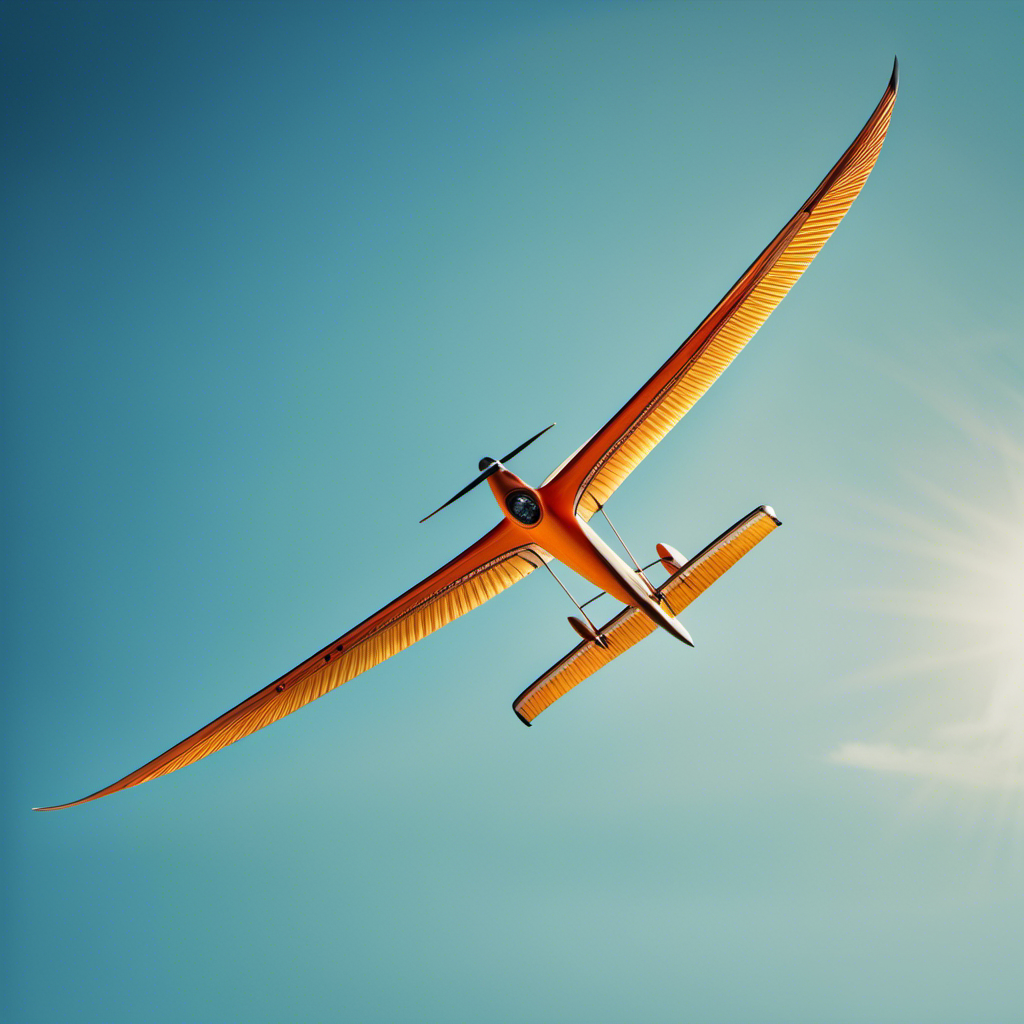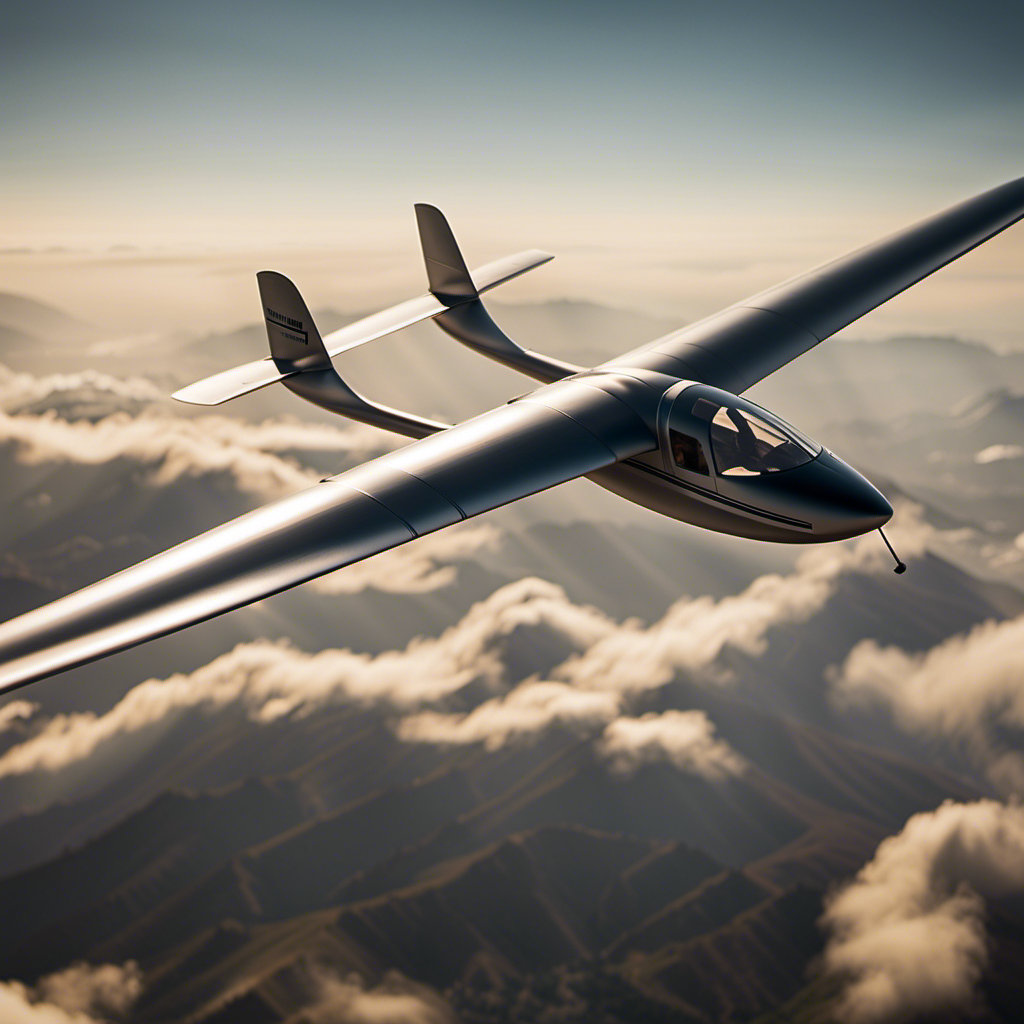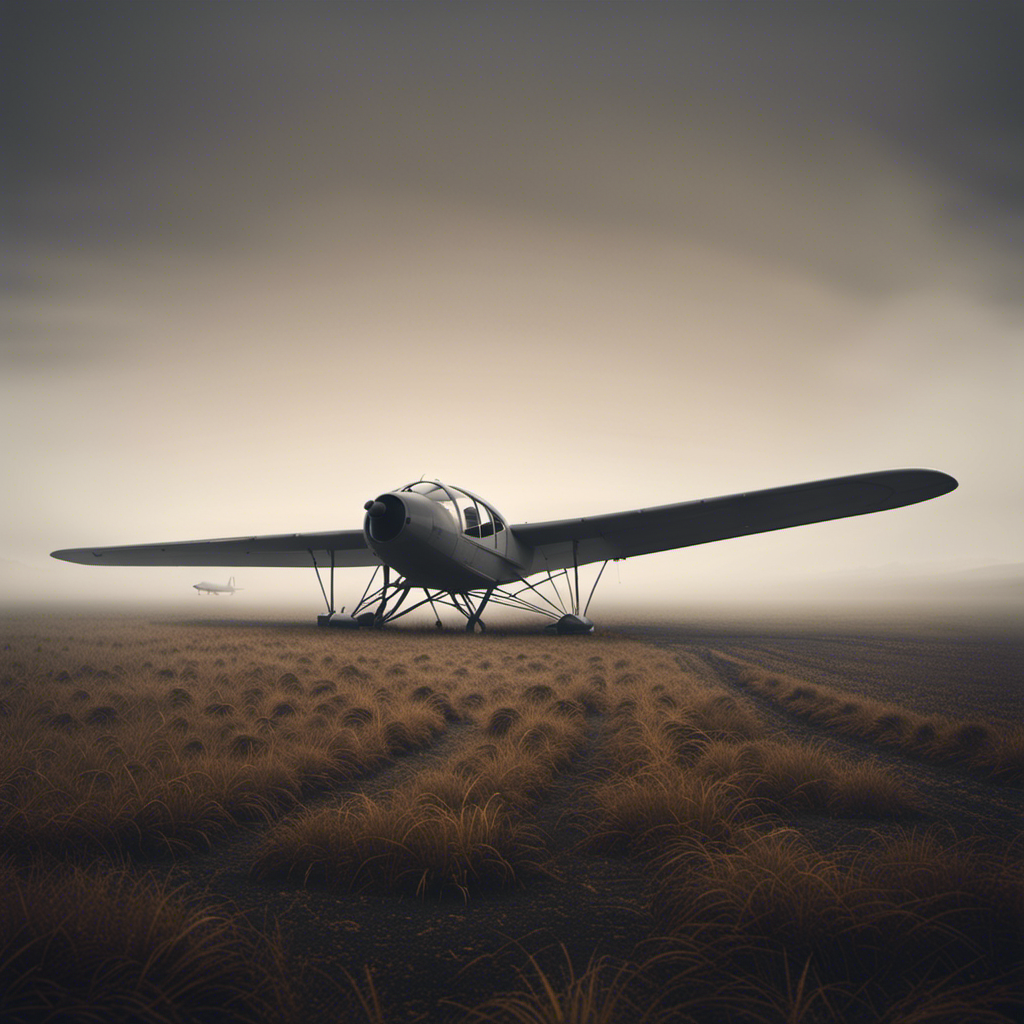As a glider pilot, I am always amazed by the elegance and beauty of glider flight. Soaring through the sky and smoothly gliding with the air currents provides an incredibly thrilling experience.
But just how long can a glider stay aloft, defying gravity and relying solely on the forces of nature? In this article, we will delve into the science behind glider flight, explore the factors that affect flight duration, discuss world records, and uncover techniques for extending time in the air.
Get ready to soar with me as we uncover the secrets of glider flight endurance.
Key Takeaways
- Glider flight duration is influenced by various factors including weather conditions, pilot skills, and the type of glider being used.
- The ability to assess surroundings and choose appropriate landing areas is crucial for safe landing procedures.
- Monitoring weather forecasts and understanding the impact of weather on flight is important for navigating changing weather patterns.
- Dealing with turbulence and wind shear requires maintaining control, making necessary adjustments, and staying focused throughout the flight.
The Science Behind Glider Flight
To understand how long you can stay in the air with a glider, it’s important to know the science behind glider flight. Gliders rely on the principles of aerodynamics to stay airborne without an engine.
One key factor that enables gliders to gain altitude and extend their flight time is thermal lift. Thermal lift occurs when the sun heats the ground, causing the air to rise in columns called thermals. Glider pilots can exploit these thermals by circling within them, gaining altitude as they ride the rising air.
Factors Affecting Glider Flight Duration
You can increase the duration of your glider flight by considering various factors.
One of the key elements to consider is glider flight efficiency. This refers to how well the glider can maintain lift and minimize drag. A streamlined design, smooth surface, and efficient wingspan all contribute to improved flight efficiency.
Another critical factor is the impact of weight on glider duration. The lighter the glider, the longer it can stay in the air. By reducing unnecessary weight, such as excess equipment or unnecessary accessories, you can maximize your flight time. Additionally, proper weight distribution is essential for optimal glider performance. Balancing the weight evenly throughout the glider ensures stability and efficient flight.
Considering these factors will help you achieve longer and more enjoyable glider flights.
Transitioning to the subsequent section about ‘world records in glider flight duration,’ it is fascinating to see how glider pilots have pushed the boundaries of endurance in the air.
World Records in Glider Flight Duration
Transitioning to the subsequent section about world records in glider flight duration, it’s fascinating to see how pilots have pushed the boundaries of endurance in the air.
The world record holders in glider flight duration have employed various strategies to achieve their remarkable feats. One such strategy is finding optimal weather conditions, including strong thermals and stable atmospheric conditions, which allow the glider to stay aloft for longer periods.
Another strategy involves careful route planning, where pilots choose flight paths that maximize the use of updrafts and reduce the need for excessive energy expenditure. Additionally, record-breaking pilots often prioritize weight reduction, employing lightweight materials and minimizing unnecessary equipment.
By implementing these strategies, world record holders have been able to extend their glider flight durations to unprecedented lengths.
Transitioning to the subsequent section about techniques for extending glider flight time, pilots continue to explore new possibilities in the realm of endurance flying.
Techniques for Extending Glider Flight Time
When it comes to extending glider flight time, there are several key techniques to consider.
One of these techniques is utilizing soaring and ridge lift, which involves taking advantage of rising air currents created by the terrain.
Another technique is dynamic soaring, where the glider gains energy by repeatedly crossing between areas of differing wind speeds.
Lastly, wave lift and the mountain wave phenomenon can significantly extend flight time, as gliders can ride the vertical waves created by wind hitting mountains or other obstacles.
Soaring and Ridge Lift
If you want to maximize your time in the air, try finding areas with strong thermal currents and ridge lift. Soaring techniques and understanding glider performance are key to staying aloft for longer durations. Here are four important factors to consider:
-
Thermal currents: These rising columns of warm air can provide significant lift for gliders. Look for areas where the sun has heated the ground, such as open fields or dark asphalt roads.
-
Ridge lift: When wind encounters a slope, it is forced upward, creating lift along the ridge. Find areas with steep slopes and a consistent wind direction to take advantage of this phenomenon.
-
Wind direction: Pay attention to the wind’s direction and strength. Flying into the wind can help you maintain altitude and increase airspeed.
-
Topography: Look for features like hills, mountains, or cliffs that can generate lift. These geographical formations can create updrafts that keep your glider airborne.
By understanding these soaring techniques and utilizing glider performance, you can extend your flight time.
Now, let’s explore another method for staying in the air for longer periods: dynamic soaring.
Dynamic Soaring
Dynamic soaring is a technique used by experienced pilots to gain energy from the wind gradient between two different air masses. This method is employed to maximize glider performance and extend flight duration.
By flying in a figure-eight pattern, pilots can take advantage of the varying wind speeds and directions at different altitudes. As the glider transitions from the slower air mass to the faster one, it gains speed and potential energy. This energy is then converted into kinetic energy as the glider accelerates, allowing it to climb higher and repeat the process.
Dynamic soaring requires precise control and skillful maneuvering to maintain the necessary speed differentials. By harnessing the power of dynamic soaring, pilots are able to extend their flight time and explore new horizons.
Transitioning into the subsequent section about wave lift and the mountain wave phenomenon, we delve into another technique used by glider pilots to stay aloft for extended periods.
Wave Lift and Mountain Wave Phenomenon
The wave lift and mountain wave phenomenon provide experienced pilots with an opportunity to gain energy and extend their flight time. Mountain wave dynamics occur when air flows over a mountain range, creating a series of alternating updrafts and downdrafts. Glider performance in these conditions is greatly enhanced, as the updrafts can provide a significant boost in altitude and allow the glider to soar for extended periods.
Challenges and Risks in Glider Flight
When it comes to glider flight, there are several challenges and risks that pilots must be prepared to face.
One such challenge is landing without power, requiring precise control and skill to safely bring the glider down to the ground.
Another challenge is navigating changing weather patterns, as sudden shifts in wind direction and speed can affect the glider’s flight path and require adjustments in real-time.
Lastly, pilots must be prepared to deal with turbulence and wind shear, which can cause sudden changes in altitude and pose a risk to the stability of the glider.
Landing without Power
If you can’t find a suitable landing spot, try to glide to a safe area. In this situation, it is crucial to utilize proper landing techniques and emergency procedures to ensure a successful landing without power. Here are four essential steps to follow:
-
Assess the surroundings: Look for open fields, clearings, or flat areas to land the glider safely. Avoid landing near obstacles such as trees, buildings, or power lines.
-
Establish a landing pattern: Plan your approach to the landing spot by flying in a consistent pattern, typically in a rectangular shape. This allows for better control and visibility during the descent.
-
Maintain airspeed and altitude: Keep the glider’s airspeed within the recommended range to maintain control and prevent stalling. Adjust the altitude as needed to ensure a smooth glide path.
-
Execute the landing: Begin the final descent by reducing the airspeed gradually. Aim for a touchdown at the lowest possible speed while maintaining control of the glider. Use the recommended landing technique, such as a flare or a wheel landing, depending on the glider model.
Navigating Changing Weather Patterns
Mastering landing techniques and emergency procedures in changing weather patterns allows for safer navigation during glider flight. Glider flight duration can vary depending on the weather conditions encountered during the flight.
It is crucial for glider pilots to understand how to navigate through changing weather patterns to ensure a successful and safe flight. By constantly monitoring weather forecasts and understanding the impact of changing conditions, pilots can make informed decisions to avoid dangerous situations. This includes being aware of approaching storms, wind direction changes, and turbulence.
Dealing with turbulence and wind shear requires pilots to maintain control of the glider and adjust their flight path accordingly. By anticipating these challenges and applying the appropriate techniques, pilots can safely navigate through changing weather patterns and continue their flight.
Dealing with Turbulence and Wind Shear
To handle turbulence and wind shear, you’ll need to stay focused and adjust your flight path accordingly. Dealing with turbulence can be challenging, as it involves sudden and unpredictable changes in air movement. When encountering turbulence, it is crucial to maintain control of the glider by making small and precise control inputs. This will help you ride through the turbulence smoothly without compromising safety.
Wind shear, on the other hand, refers to a sudden change in wind direction or intensity. It can be hazardous, especially during takeoff and landing. To deal with wind shear, it is essential to be aware of weather conditions and keep a close eye on wind indicators.
Safety Measures and Precautions for Glider Flight
Safety measures and precautions are essential when flying a glider to ensure a safe and enjoyable experience. Glider flight duration can vary depending on several factors, including weather conditions, pilot skills, and the type of glider being used.
It is crucial to conduct a thorough pre-flight inspection, checking for any signs of damage or malfunction. This includes inspecting the wings, control surfaces, and the cockpit area. It is also important to ensure that the glider is properly balanced and that all necessary equipment, such as a parachute and communication devices, are in good working condition.
During the flight, maintaining situational awareness and adhering to airspace regulations are vital for safety. Additionally, pilots should always be prepared for emergencies and have a contingency plan in place.
Frequently Asked Questions
How much does a glider weigh?
A glider’s weight depends on its design and materials used. The glider’s payload capacity, which includes the weight of the pilot and any additional equipment, is also a factor.
What is the average cost of a glider?
The average cost of a glider depends on various factors such as size, materials used, and features. Additionally, maintenance costs should be considered. It is important to consult with manufacturers or dealers for accurate pricing information.
Do gliders have engines?
Yes, gliders do not have engines and therefore require a runway for takeoff. There are several types of gliders, including sailplanes, motor gliders, and hang gliders, each with their unique characteristics and capabilities.
Can gliders fly at night?
Glider flying techniques at night involve using instruments and following safety measures. It is important to have proper lighting and navigation equipment, as well as knowledge of airspace regulations and weather conditions.
What is the maximum altitude a glider can reach?
The maximum altitude a glider can reach depends on various factors, including weather conditions and the glider’s design. However, glider endurance is not solely determined by altitude, but also by other factors such as lift and wind patterns.
Conclusion
In conclusion, the world of glider flight is a captivating and awe-inspiring one.
As I reflect on the science behind glider flight and the factors that affect its duration, I am reminded of the delicate balance between skill and nature’s whims.
It is a dance in the sky, where pilots push the boundaries of time, striving to break world records and extend flight durations.
However, amidst the exhilaration, one must always be mindful of the challenges and risks involved.
By adhering to safety measures and taking precautions, glider flight can continue to be a remarkable feat of human achievement and a testament to our unwavering spirit of exploration.
Orion, better known as “Jetstream,” is the voice that brings the stories of the skies to life. His fascination with aviation began at a young age, sparked by his father’s tales of flying and adventure. Orion’s journey into the world of gliding was serendipitous, and from the moment he took his first glider flight, he knew he had found his calling.
